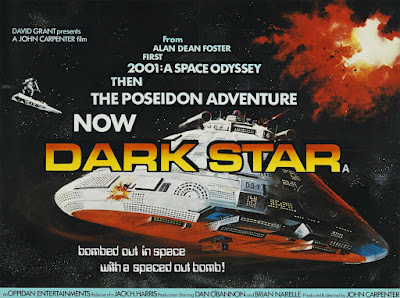Celebrating
its golden jubilee at 50 years since its theatrical debut at LA's
Filmax festival on March 30th, 1974, it's the directorial debut of John
Carpenter with his weirdo science fiction hippie comedy, Dark Star.
What started out as a film school project in 1970 eventually became a
cult classic with the dawn of the home video revolution in the 1980s.
Dark
Star began life as a rough concept by Carpenter while he was a film
student at the University of Southern California. Dan O'Bannon was also
a student there at the time and became a principal collaborator on the
project, fleshing out the script, developing the production design and
figuring out the special effects. Carpenter, in addition to directing
and script collaboration, also created the soundtrack, utilizing his
modular synthesizer system. Principal photography began in 1970 on 16mm
film with a slim budget of $1000, a sum that would balloon to $6000 by
the time they'd finished work on the initial 45 minute cut, late in
1972. The results of their efforts were enough to inspire the pair to
try to push the film past the student production bar and towards an
actual commercial theatrical release.
In order to get the movie
to the level of a feature film, they would have to fill it out with
roughly double the footage they had already shot, so a series of
additional shoots were done in 1973 to add a number of sequences to the
story. These included the asteroid storm, Doolittle playing bottles on
strings as a musical instrument, the scenes in the crew sleeping
quarters, the scenes in the hallways of the ship (Pinback with the
sunlamp, Boiler with the laser gun, etc.), and, importantly, all the
scenes featuring the beach ball alien.
John Landis, a friend of
O'Bannon, got the pair hooked up with producer-distributor Jack H.
Harris, who obtained the theatrical distribution rights. Once in his
hands, he insisted on further revisions in order to get the production
values up to professional standards, demanding extensive cuts of
numerous scenes, deeming about 30 minutes of the film "unwatchable",
including a protracted scene of the crew sleeping and ignoring messages
from the ship's systems. He insisted on additional 35mm footage being
added to the film, and mandated other edits intended to secure a "G"
rating for the film's release. The end results may have created the
best looking student film ever produced, but in terms of commercial
professional Hollywood production standards, it barely passed muster.
Despite
the shaky nature of the production, the visual FX still managed to
create some striking imagery, especially in its depiction of the ship
jumping into hyperspace as it kicked into faster-than-light speed. The
imagery of the light rays bleeding past the ship as it accelerated are
the first on screen representations of that process ever filmed. It's a
depiction that would become common in virtually every science fiction
property in later years, from Star Wars to Star Trek. Then there was
the ludicrous "beach ball" alien, something that was intended to be
comical, but which ultimately served as the foundational inspiration for
O'Bannon when he worked on Alien.
The story of a rag-tag group
of dispirited astronauts on a 20 year long mission to destroy rogue
planets using "smart bombs" was one that flew in the face of the more
glamorous and inspirational depictions of life in space that had
dominated the genre for so long. There was nothing heroic or exciting
about their work. It was protracted drudgery that ultimately drives
even their AI enabled bombs mad. And while its initial theatrical
audiences didn't get the joke and the film failed to garner any
significant box office upon its release, when the home video market
sprung into life at the dawn of the '80s, film nerds looking for
something different in the sci-fi section quickly discovered its quirky
charms, propelling it to the realms of cult classic within a few years.
Critics were also surprisingly generous with their reviews, with Roger
Ebert giving the movie three stars out of four, writing: "Dark Star is
one of the damnedest science fiction movies I've ever seen, a berserk
combination of space opera, intelligent bombs, and beach balls from
other worlds."
Its influence on later films is also impressive,
not only in terms of the aforementioned visual FX, but also in the
production of other comic science fiction properties. Doug Naylor has
said in interviews that Dark Star was the inspiration for Dave Hollins:
Space Cadet, the radio sketches that evolved into his popular science
fiction sitcom, Red Dwarf. For its creators, while the project may have
suffered some during its journey towards its final form, it's legacy
remains as one of the more beloved oddities of the genre created in the
heyday of '70s science fiction adventurism.
